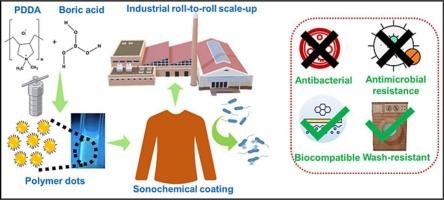From lab to pilot: sonochemical coating of PDDA-based polymer dots for scalable, wash-durable antibacterial textiles
IF 9.7
1区 化学
Q1 ACOUSTICS
引用次数: 0
Abstract
Poly(diallyldimethylammonium chloride) (PDDA) is a cationic polymer with strong antibacterial activity, but its coating applications are hindered by limited stability and dose-dependent cytotoxicity. Nanoformulating PDDA into polymer dots (PDDA-based PDs) via hydrothermal synthesis with boric acid offers enhanced biocompatibility, stability, and antimicrobial efficacy. The synthesised PDs demonstrated potent antibacterial activity against Gram-positive (S. aureus) and Gram-negative bacteria (E. coli and P. aeruginosa) with MIC values of 0.056–0.112 mg/mL and superior biofilm inhibition capabilities. Significantly lower antimicrobial resistance development was observed, with only 4–8 fold MIC increase after 30 days compared to 128–2048 fold increase for conventional antibiotics. Sonochemical coating onto cotton fabrics achieved exceptional washing durability, retaining strong antibacterial activity even after 60 high-temperature hospital laundry cycles with log reductions of 4.72 for S. aureus, 2.31 for P. aeruginosa, and 3.26 for E. coli. The multi-targeted antimicrobial mechanism of the PDs involves ROS generation, disruption of bacterial metabolism, and physical damage to membrane integrity. The coating process was successfully upscaled using a roll-to-roll sonochemical pilot system, demonstrating industrial feasibility. PDDA-based PDs offer a promising platform for developing sustainable, wash-durable antimicrobial textiles suitable for healthcare applications.

从实验室到试验:用于可伸缩,耐洗抗菌纺织品的pda基聚合物点的声化学涂层。
聚二烯基二甲基氯化铵(PDDA)是一种具有较强抗菌活性的阳离子聚合物,但其稳定性和剂量依赖性的细胞毒性限制了其涂层的应用。利用硼酸水热合成技术将PDDA纳米合成为聚合物点(PDDA基pdds),提高了PDDA的生物相容性、稳定性和抗菌效果。合成的pd对革兰氏阳性菌(金黄色葡萄球菌)和革兰氏阴性菌(大肠杆菌和铜绿假单胞菌)具有较强的抗菌活性,MIC值为0.056 ~ 0.112 mg/mL,具有良好的生物膜抑制能力。观察到抗菌素耐药性发展显著降低,30天后MIC仅增加4-8倍,而常规抗生素增加128-2048倍。棉织物上的声化学涂层具有优异的洗涤耐久性,即使在60次高温医院洗衣循环后仍保持强大的抗菌活性,金黄色葡萄球菌的对数减少4.72,铜绿假单胞菌的对数减少2.31,大肠杆菌的对数减少3.26。PDs的多靶点抗菌机制包括ROS的产生、细菌代谢的破坏和对膜完整性的物理损伤。使用卷对卷声化学中试系统,涂层工艺成功升级,证明了工业可行性。基于pdda的pd为开发适用于医疗保健应用的可持续、耐洗抗菌纺织品提供了一个有前途的平台。
本文章由计算机程序翻译,如有差异,请以英文原文为准。
求助全文
约1分钟内获得全文
求助全文
来源期刊

Ultrasonics Sonochemistry
化学-化学综合
CiteScore
15.80
自引率
11.90%
发文量
361
审稿时长
59 days
期刊介绍:
Ultrasonics Sonochemistry stands as a premier international journal dedicated to the publication of high-quality research articles primarily focusing on chemical reactions and reactors induced by ultrasonic waves, known as sonochemistry. Beyond chemical reactions, the journal also welcomes contributions related to cavitation-induced events and processing, including sonoluminescence, and the transformation of materials on chemical, physical, and biological levels.
Since its inception in 1994, Ultrasonics Sonochemistry has consistently maintained a top ranking in the "Acoustics" category, reflecting its esteemed reputation in the field. The journal publishes exceptional papers covering various areas of ultrasonics and sonochemistry. Its contributions are highly regarded by both academia and industry stakeholders, demonstrating its relevance and impact in advancing research and innovation.
 求助内容:
求助内容: 应助结果提醒方式:
应助结果提醒方式:


